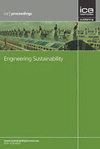Net zero carbon dioxide emissions in flood defence schemes
IF 1.5
4区 工程技术
Q3 ENGINEERING, CIVIL
Proceedings of the Institution of Civil Engineers-Engineering Sustainability
Pub Date : 2022-03-30
DOI:10.1680/jensu.21.00099
引用次数: 0
Abstract
This paper compares the carbon dioxide emissions of constructing flood protection schemes to the emissions saved by providing flood defences. There is considerable information available on the carbon dioxide ‘cost’ of construction, but less on repairing flooded properties. Drawing on existing research into flooding, this paper identifies a carbon dioxide cost of repairs of 6 tCO2e per property flooded, and uses this to provide a method to determine emissions benefit for constructing flood protection schemes. While emissions reduction should be the first priority, flood defences defend against future emissions. Using Stonehaven in the UK as a case study, this paper demonstrates that the carbon dioxide cost of constructing a flood protection scheme can be less than the carbon dioxide cost of undertaking repairs following flooding over the life of a scheme, with a benefit ratio of 2 identified for the case study scheme. The paper concludes with a review of the UK government appraisal process, and cautions that the carbon dioxide cost produced by a flood protection scheme may not differentiate an option when compared to capital cost. It is considered that an independent assessment should be undertaken to demonstrate a net zero emissions option is selected.防洪计划的二氧化碳净零排放
本文将建设防洪方案的二氧化碳排放量与提供防洪设施所节省的排放量进行了比较。关于建筑的二氧化碳“成本”有相当多的信息,但关于修复被淹房屋的信息却很少。根据对洪水的现有研究,本文确定了每栋被洪水淹没的房屋的修复二氧化碳成本为6亿吨二氧化碳当量,并利用这一成本提供了一种确定建设洪水保护方案的排放效益的方法。虽然减排应该是首要任务,但防洪系统可以防止未来的排放。本文以英国的斯通黑文(Stonehaven)作为案例研究,证明了在方案的整个生命周期内,建设防洪方案的二氧化碳成本可以低于在洪水后进行维修的二氧化碳成本,并确定了案例研究方案的效益比为2。这篇论文最后回顾了英国政府的评估过程,并警告说,与资本成本相比,洪水保护计划产生的二氧化碳成本可能无法区分一个选择。委员会认为,应进行独立评估,以证明选择了净零排放方案。
本文章由计算机程序翻译,如有差异,请以英文原文为准。
求助全文
约1分钟内获得全文
求助全文
来源期刊

Proceedings of the Institution of Civil Engineers-Engineering Sustainability
ENGINEERING, CIVIL-ENGINEERING, CIVIL
CiteScore
3.70
自引率
16.70%
发文量
44
审稿时长
>12 weeks
期刊介绍:
Engineering Sustainability provides a forum for sharing the latest thinking from research and practice, and increasingly is presenting the ''how to'' of engineering a resilient future. The journal features refereed papers and shorter articles relating to the pursuit and implementation of sustainability principles through engineering planning, design and application. The tensions between and integration of social, economic and environmental considerations within such schemes are of particular relevance. Methodologies for assessing sustainability, policy issues, education and corporate responsibility will also be included. The aims will be met primarily by providing papers and briefing notes (including case histories and best practice guidance) of use to decision-makers, practitioners, researchers and students.
 求助内容:
求助内容: 应助结果提醒方式:
应助结果提醒方式:


